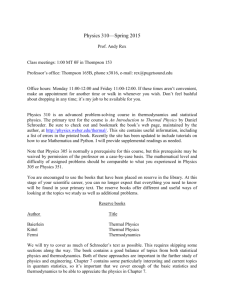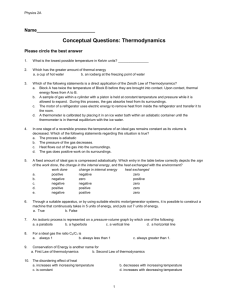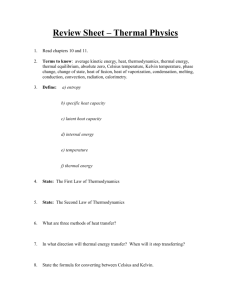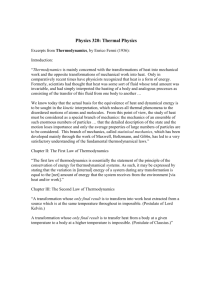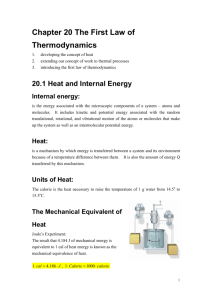First Law of Thermodynamics - Erwin Sitompul
advertisement
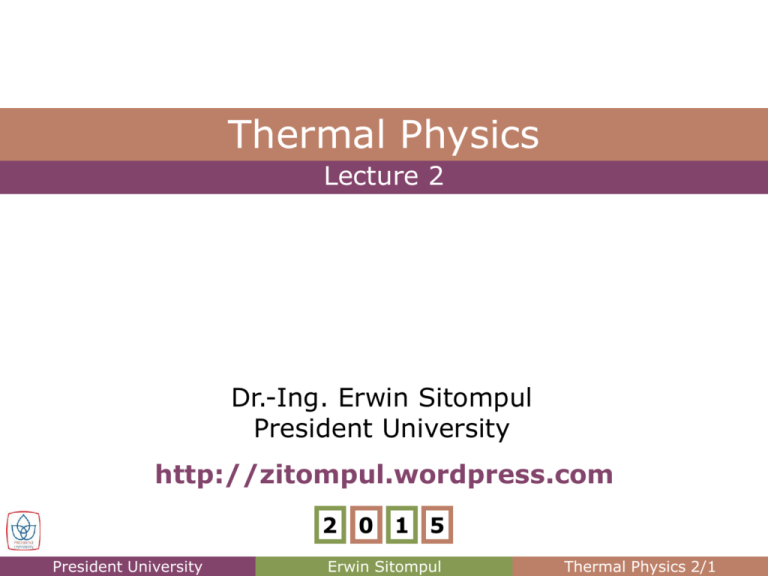
Thermal Physics Lecture 2 Dr.-Ing. Erwin Sitompul President University http://zitompul.wordpress.com 2 0 1 5 President University Erwin Sitompul Thermal Physics 2/1 Chapter 18 First Law of Thermodynamics The Absorption of Heat by Solids and Liquids Heat Capacity The heat capacity C of an object is the proportionality constant between the heat Q that the object absorbs or loses and the resulting temperature change ΔT of the object. Q C T C (T f Ti ) Tf Ti C : final temperature of the object : initial temperature of the object : heat capacity [cal/°C], [J/K] Specific Heat Capacity Specific heat capacity c is defined as “heat capacity per unit mass.” It refers not to an object but to a unit mass of the material of which the object is made. Q cmT cm(T f Ti ) The specific heat of water, as the reference in defining calorie, is: c 1cal g C 1 Btu lb F 4190 J kg K President University Erwin Sitompul Thermal Physics 2/2 Chapter 18 First Law of Thermodynamics The Absorption of Heat by Solids and Liquids Molar Specific Heat In many instances the most convenient unit for specifying the amount of a substance is the mole (mol), where: 1 mol 6.02 1023 elementary units When quantities are expressed in moles, specific heats must also involve moles (rather than a mass unit.) They are called molar specific heats. President University Erwin Sitompul Thermal Physics 2/3 Chapter 18 First Law of Thermodynamics The Absorption of Heat by Solids and Liquids Heats of Transformation When energy is absorbed as heat by a solid or liquid, the temperature of the sample does not necessarily rise. Instead, the sample may change from one phase, or state, to another, with no change in temperature. The amount of energy per unit mass that must be transferred as heat when a sample completely undergoes a phase change is called the heat of transformation L. Thus, when a sample of mass m completely undergoes a phase change, the total energy transferred is: Q Lm President University Erwin Sitompul Thermal Physics 2/4 Chapter 18 First Law of Thermodynamics The Absorption of Heat by Solids and Liquids When the phase change is from liquid to gas (the sample absorbs heat) or from gas to liquid (the sample releases heat), then heat of transformation is called the heat of vaporization LV. When the phase change is from solid to liquid (the sample absorbs heat) or from liquid to solid (the sample releases heat), the heat of transformation is called the heat of fusion LF. President University Erwin Sitompul Thermal Physics 2/5 Chapter 18 First Law of Thermodynamics The Absorption of Heat by Solids and Liquids Consider the energy required to convert a 1.00-g block of ice at – 30.0°C to steam at 120.0°C. President University Erwin Sitompul Thermal Physics 2/6 Chapter 18 First Law of Thermodynamics Problem (a) How much heat must be absorbed by ice of mass m = 720 g at – 10°C to take it to liquid state at 15°C? (b) If we supply the ice with a total energy of only 210 kJ (as heat), what then are the final state and temperature of the water? (a) Qtotal Q1 Q2 Q3 cice m(0 Ti ) LF m cwater m(T f 0) (2220)(0.720)(0 (10)) (333 k)(0.720) (4180)(0.720)(15 0) 15.98 kJ 239.76 kJ 45.144 kJ 300 kJ (b) 210 kJ is not enough to melt all the ice. The remaining heat for melting is 210 kJ – 15.98 kJ = 194.02 kJ = 80.92% of 239.76 kJ Thus, 80.92% of ice (582.62 g) will to water while 19.08% of ice (137.38 g) will stay as ice. President University Erwin Sitompul Thermal Physics 2/7 Chapter 18 First Law of Thermodynamics Problem A copper slug whose mass mc is 75 g is heated in a laboratory oven to a temperature T of 312°C. The slug is then dropped into a glass beaker containing a mass mw =220 g of water. The heat capacity Cb of the beaker is 45 cal/K. The initial temperature Ti of the water and the beaker is 12°C. Assuming that the slug, the beaker and water are an isolated system and the water does not vaporize, find the final temperature Tf of the system at thermal equilibrium. cc 386 J kg K Cb 45cal K 188.55J K Qc Qw Qb cw 4180 J kg K cc mc (Tc T ) cw mw (T Tw ) Cb (T Tb ) (386)(0.075)(312 T ) (4180)(0.22)(T 12) (188.55)(T 12) (9032.4 28.95T ) (919.6T 11035.2) (188.55T 2262.6) 1137.1T 22330.2 T 19.64C President University Erwin Sitompul Thermal Physics 2/8 Chapter 18 First Law of Thermodynamics A Closer Look at Heat and Work Consider a gas –as a system– confined to a cylinder with a movable piston. The system starts from an initial state i, with pressure pi, volume Vi, and temperature Ti. We want to change the system to a final state f, described by pressure pf, volume Vf, and temperature Tf. The procedure of bringing the system from its initial state to its final state is called a thermodynamic process, where: Heat Q can be added to the gas (positive heat) or withdrawn from it (negative heat), by regulating the temperature of the adjustable thermal reservoir. Work W can be done by the gas by raising the piston (positive work) or lowering it (negative work). We assume that all such change occur slowly the system is always in (approximate) thermal equilibrium the temperature of every part of the gas is always the same. President University Erwin Sitompul Thermal Physics 2/9 Chapter 18 First Law of Thermodynamics A Closer Look at Heat and Work Suppose a few lead shot is removed, allowing the gas to push the piston and remaining shot upward → through a differential → displacement ds with an upward force F. The differential work dW done by the gas during the displacement is: dW F d s ( pA)(ds) ( p)( Ads ) ( p )(dV ) If the gas changes its volume from Vi to Vf, the total work done by the gas is: W dW Vf pdV Vi President University Erwin Sitompul Thermal Physics 2/10 Chapter 18 First Law of Thermodynamics A Closer Look at Heat and Work A system can be taken from a given initial state to a given final state by an infinite number of processes. Heat may or may not be involved. In general, the work W and the heat Q will have different values from different processes. Heat and work are path-dependent quantities. President University Erwin Sitompul Thermal Physics 2/11 Chapter 18 First Law of Thermodynamics A Closer Look at Heat and Work ia : Q > 0 ib : Q < 0 af : Q < 0 b Positive work More positive work bf : Q > 0 Less positive work Wighf > Wicdf Amount of work depends on path President University Negative work Net positive work Erwin Sitompul Thermal Physics 2/12 Chapter 18 First Law of Thermodynamics Checkpoint The p-V diagram on the right shows six curved paths (connected by vertical paths) that can be followed by a gas. Which two of the curved paths should be part of a closed cycle if the net work done by the gas during the cycle is to be at its maximum positive value? c and e, which will result the maximum area enclosed by a clockwise cycle President University Erwin Sitompul Thermal Physics 2/13 Chapter 18 First Law of Thermodynamics The First Law of Thermodynamics Previously we have seen, that when a system changes from a given initial state to a given final state, both the work W and the heat Q depend on the nature (path) of the process. The quantity (Q–W) is however the same for all process. It depends only on the initial and final stated. The quantity (Q–W) must represent a change in some intrinsic property of the system. We call it the internal energy Eint and we write: Eint Eint, f Eint,i Q W First Law of Thermodynamics If the thermodynamic system undergoes only a differential change, we can write the first law as: dEint dQ dW First Law of Thermodynamics The kinetic energy or the potential energy of the system as a whole is assumed to be unchanged, ΔK = ΔU = 0. President University Erwin Sitompul Thermal Physics 2/14 Chapter 18 First Law of Thermodynamics Checkpoints The figure on the right shows four paths on a p-V diagram along which a gas can be taken from state i to state f. Rank the path according to: (a) the change ΔEint in the internal energy of the gas, (b) the work W done by the gas, and (c) the magnitude of the energy transferred as heat Q between the gas and its environment, greatest first. (a) All tie (b) 4, 3, 2, 1. (area under the curve) (c) 4, 3, 2, 1. (Q = ΔEin + W) President University Erwin Sitompul Thermal Physics 2/15 Chapter 18 First Law of Thermodynamics Some Special Cases of the First Law of Thermodynamics Adiabatic processes. An adiabatic process is one that occurs so rapidly or occurs in a system that is so well insulated that no transfer of energy as heat occurs between the system and its environment. Eint W Constant-volume processes. If the volume of a system is held constant, that system can do no work, since W = pΔV. Eint Q Cyclical processes. There are processes in which, after certain interchanges of heat and work, the system is restored to its initial state. In this case, no intrinsic property of the system can change. Q W Free expansions. These are adiabatic processes in which no transfer of heat occurs between the system and its environment and no work is done on or by the system. Eint 0 President University Erwin Sitompul Thermal Physics 2/16 Chapter 18 First Law of Thermodynamics Some Special Cases of the First Law of Thermodynamics ● Free expansion President University Erwin Sitompul ● Adiabatic process Thermal Physics 2/17 Chapter 18 First Law of Thermodynamics Checkpoint For one complete cycle as shown in the p-V diagram here, are (a) ΔEint for the gas and (b) the net energy transferred as heat Q positive, negative or zero? (a) ΔEint = 0 (closed cycle) (b) Q < 0 (Q = W, while W < 0 for ccw cycle) President University Erwin Sitompul Thermal Physics 2/18 Chapter 18 First Law of Thermodynamics Problem Let 1.00 kg of liquid water at 100 °C be converted to steam at 100°C by boiling at standard atmospheric pressure (= 1.00 atm or 1.01×105 Pa) in the arrangement as shown below. The volume of that water changes from an initial value of 1.00×10–3 m3 as a liquid to 1.671 m3 as steam. (a) How much work is done by the system during this process? W pV (1.01105 )(1.671 1.00 103 ) 168771 J 168.77 kJ President University Erwin Sitompul Thermal Physics 2/19 Chapter 18 First Law of Thermodynamics Problem Let 1.00 kg of liquid water at 100 °C be converted to steam at 100°C by boiling at standard atmospheric pressure (= 1.00 atm or 1.01×105 Pa) in the arrangement as shown below. The volume of that water changes from an initial value of 1.00×10–3 m3 as a liquid to 1.671 m3 as steam. (b) How much energy is transferred as heat during the process? Q LV m (2256 k)(1.00) 2256 kJ (c) What is the change in the system’s internal energy during the process? Eint Q W 2256 k 168.77 k 2087.23 kJ 23087 MJ President University ?How to achieve efficient boiling in daily life? Erwin Sitompul Thermal Physics 2/20 Chapter 18 First Law of Thermodynamics Class Group Assignments 1. A 0.050-kg ingot of metal is heated to 200.0°C and then dropped into a beaker containing 0.400 kg of water initially at 20.0°C. The final equilibrium temperature of the mixed system is 22.4°C. The specific heat of the metal is (in J/kg·K): (a) 217.8 (d) 681.0 (b) 451.9 (e) 1368.1 (c) 562.2 2. A series of thermodynamic processes is shown in the next p-V diagram. Heat is added to the system, during process ab as much as 150 J and during process bd 600 J. The internal energy changes (ΔEint) of process ab and abd are, respectively,: (a) 90 J and 510 J (d) 150 J and 360 J (b) 310 J and 360 J (e) 310 J and 240 J (c) 150 J and 510 J 3. A system undergoes an adiabatic process in which its internal energy increases by 20 J. Which of the following statement is true? (a) 20 J of work was done on the system (b) 20 J of work was done by the system (c) The system received 20 J of energy as heat (d) The system lost 20 J of energy as heat (e) None of the above are true President University Erwin Sitompul Thermal Physics 2/21 Chapter 18 First Law of Thermodynamics Homework 2 1. (18-41) (a) Two 50-g ice cubes are dropped into 200 g of water in a thermally insulated container. If the water is initially at 25°C, and the ice comes directly from a freezer at –15°C, what is the final temperature at thermal equilibrium? (b) What is the final temperature if only one ice cube is used? 2. (18-49) When a system is taken from state i to state f along path iaf, Q = 50 cal and W = 20 cal. Along path ibf, Q = 36 cal. (a) What is W along path ibf? (b) If W = –13 cal for the return path fi, what is Q for this path? (c) If Eint,i = 10 cal, what is Eint,f? (d) If Eint,i = 10 cal and Eint,b = 22 cal, what is Q for path ib and bf? Deadline: 23 April 2015. President University Erwin Sitompul Thermal Physics 2/22
